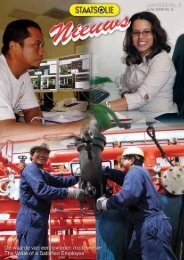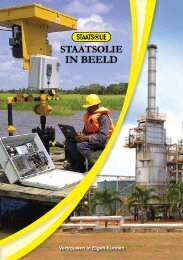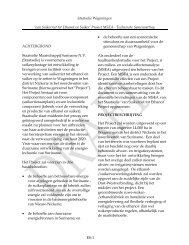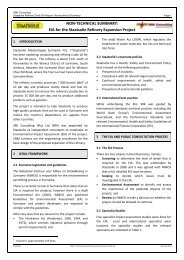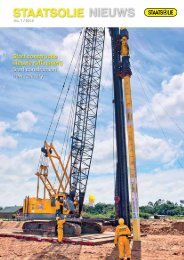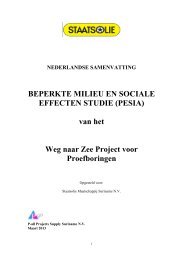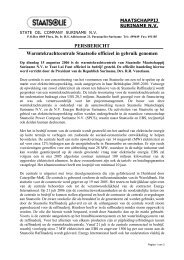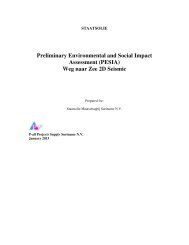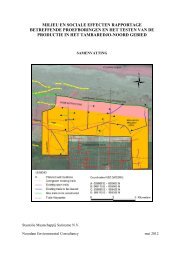concept EIA-rapport - Staatsolie
concept EIA-rapport - Staatsolie
concept EIA-rapport - Staatsolie
Create successful ePaper yourself
Turn your PDF publications into a flip-book with our unique Google optimized e-Paper software.
SRK Consulting: Project No: 439414 <strong>Staatsolie</strong> Pipeline <strong>EIA</strong> – Draft <strong>EIA</strong> Report Page 15<br />
3.3.3 Construction<br />
The majority of the pipeline route (some 5 240 m out of a total 6 350 m) will be constructed<br />
using HDD. HDD is a steerable trenchless method of installing underground pipes, conduits<br />
and cables in a shallow arc along a prescribed bore path by using a surface launched drilling<br />
rig, with minimal impact on the surrounding area. This method is typically employed when<br />
trenching or excavating is not practical, using a specialised machine with a drill head that can<br />
be guided during the drilling operation.<br />
The branches of the pipelines leading from the exit point at the SOL-SUHOZA jetty to OGANE<br />
and SOL-SUHOZA will be laid using conventional trenching. The last ~20 m of the pipeline<br />
connecting to the equipment at OGANE and SOL-SUHOZA will be placed on pole supports<br />
and elevated some 0.5 m above ground. Approximately 70 m of pipeline will be laid using<br />
conventional trenching between the entry and exit points on the Bruynzeel site.<br />
It is anticipated that pipeline construction will start in the first quarter of 2013, with early civil<br />
works (earth preparation for the HDD work areas) in the third quarter of 2012. In total, pipeline<br />
installation is expected to take 8 to 10 months.<br />
3.3.3.1 Drill pads<br />
Before drilling can commence, drill pads will be constructed at exit points, notably near the<br />
SOL jetty and the <strong>Staatsolie</strong> refinery, to support the drill rig and associated works. Pads will<br />
thus be located in areas currently used or earmarked for industrial purposes. The pads will<br />
extend 20 to 30 m from the high water mark into the river and will be constructed by filling the<br />
area with sand to raise it above water level. A bund will be constructed around the drill entry /<br />
exit point to create a buffer to contain the drilling mud during construction.<br />
The layout of each drill pad will vary depending on the local conditions and space constraints<br />
and will be discussed with the respective landowners and MAS. Each pad is likely to occupy<br />
up to 2 500 m 2 (0.25 ha) and include the following elements:<br />
• Drill rig;<br />
• Operating cabin;<br />
• Hiab truck-mounted crane;<br />
• Drill pipe storage;<br />
• Deadman 4 ;<br />
• Drill mud pit;<br />
• Canteen;<br />
• Generator;<br />
• Storage;<br />
• Pump;<br />
• Drill mud tank;<br />
• Water tank;<br />
• Mixing unit and mud recycling unit;<br />
• Drill mud storage area.<br />
One drill rig with a pulling force of 250 tonnes will be used and moved to the various points<br />
where drilling will be executed. The bore path will be drilled from the exit point, as the pipeline<br />
will be pulled back into the hole from the entry point at the opposite end of the drill section.<br />
The rig will be jacked up on the drill pad to allow the drill to penetrate the ground at the<br />
required angle (see Figure 3-3).<br />
4 A piece of wood or concrete, usually buried, to which a wire guy line is attached for bracing a mast or tower.<br />
REUT/DALC 439414_<strong>Staatsolie</strong>Pipeline<strong>EIA</strong>_Draft <strong>EIA</strong> Report_Final<br />
June 2012




